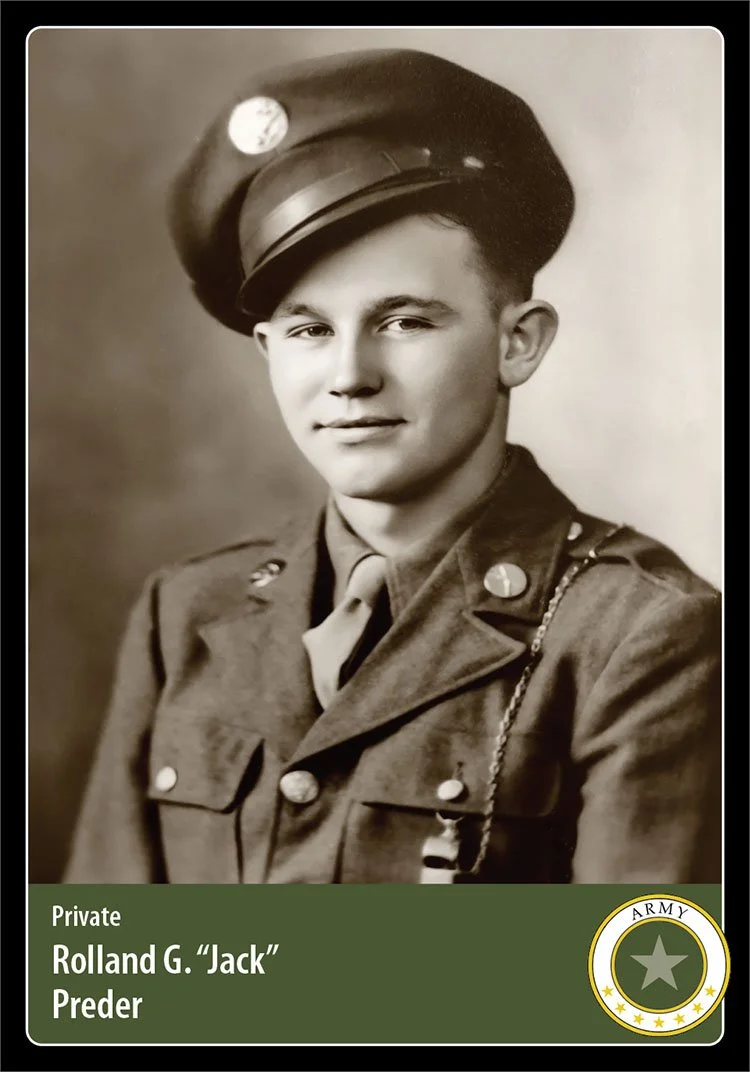Hero Card 237, Card Pack 20
Photo (digitally enhanced) provided by the family.
Hometown: Gibbsville, WI
Branch: U.S. Army
Unit: Company B, 38th Armored Infantry Battalion, 7th Armored Division
Military Honors: Purple Heart
Date of Sacrifice: April 7, 1945 - KIA in Niedersorpe, Germany
Age: 18
Conflict: World War II, 1939-1945
As one of 10 children, Rolland Preder was known as “Jack”—making it easier to distinguish him from twin brother Rollen. In Gibbsville, a tiny Dutch immigrant settlement in eastern Wisconsin, parents Garret and Jennie (Dekker) Preder raised nine children: Gordon, Lloyd, Warren, Betty Jane, twins Margaret and Marjorie, another set of twins Rolland and Rollen, and Frederick. They also raised Gordon’s daughter, Jane, as their own child.
Besides a few homes, Gibbsville consisted of a three-room school, a general store, and a Dutch Reformed Church that served as a hub for the dairy farming community around it. The Preder family lived across the street from the general store and made their living by obtaining and selling scrap metal.
In the costliest conflict in human history (World War II, 1939-1945), the Preder family would send five sons to help liberate Europe from Nazi occupation, and to defeat Imperial Japan in the Pacific. A sixth son, Frederick, would also serve during the Korean War (1950-1953).
By the time young “Jack” entered the service on July 31, 1944, the Preders had already lost older brother Gerald—less than a year earlier—in the Allied campaign to force the German Army out of Italy.
Jack was sent to Fort Sheridan, Illinois for Army training, then to Fort Robinson, Arkansas and Fort Meade, Maryland. He was trained as a rifleman and assigned to Company B, 38th Armored Infantry Battalion, 7th Armored Division.
PVT Jack Preder shipped off for Europe in January of 1945, as the Allied forces were gaining ground against the German Army, and hopes for a final victory were on the rise. On January 27, Jack’s family received word that he’d arrived safely in Belgium.
Although Germany’s Third Reich appeared to be drawing to an end—with American, British, and Canadian forces closing in from the west and Stalin’s Russian Army advancing from the east—Adolph Hitler plotted one last massive attempt to divide the invading armies.
In December and January of 1945, the “Battle of the Bulge” cost the Western Allies more than 80,000 casualties—mostly American. Germany suffered at least as many. One of the largest and most costly battles of World War II ended with an Allied victory, opening the door for a final invasion of Hitler’s Germany from the east.
As his battalion pushed eastward, deep into Germany itself, PVT Rolland “Jack” Preder was killed in battle near the small town of Niedersorpe on April 7, 1945. Nazi Germany would surrender just a month later, on May 7, 1945—bringing an end to the war in Europe.
After a second Preder son was lost in the war, their surviving brothers received a letter from the War Department dismissing them from further service.
Knowing personally the high cost of serving his country, at age 18 Rolland “Jack” Preder left the comfort and safety of home to give “the last full measure of devotion” to his country. He is laid to rest with his fellow soldiers in the Netherlands American Cemetery (Plot B, Row 19, Grave 8) in Margraten.
Sources
Details and card photo submitted by Mrs. Jane (Preder) Ten Haken—PVT Preder’s niece
The Sheboygan Press, Apr. 25, 1945: Gibbsville Man Is Killed In Action In Germany April 7
The Sheboygan Press, May 7, 1945: Memorial Rites Held At Gibbsville Church Friday
Pritzger Military Museum & Library: Battle of the Bulge, December 1944 – January 1945
American Battlefield Monuments Commission: Rolland G. Preder
HonorStates.org: Rolland Garret Preder
Burial Site: Find a Grave





